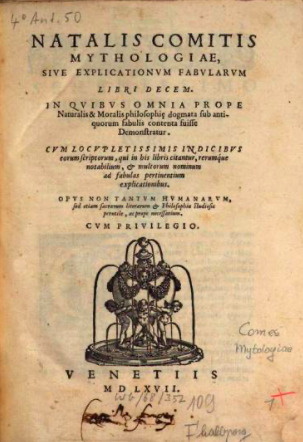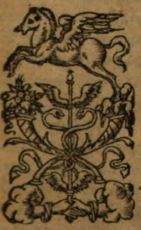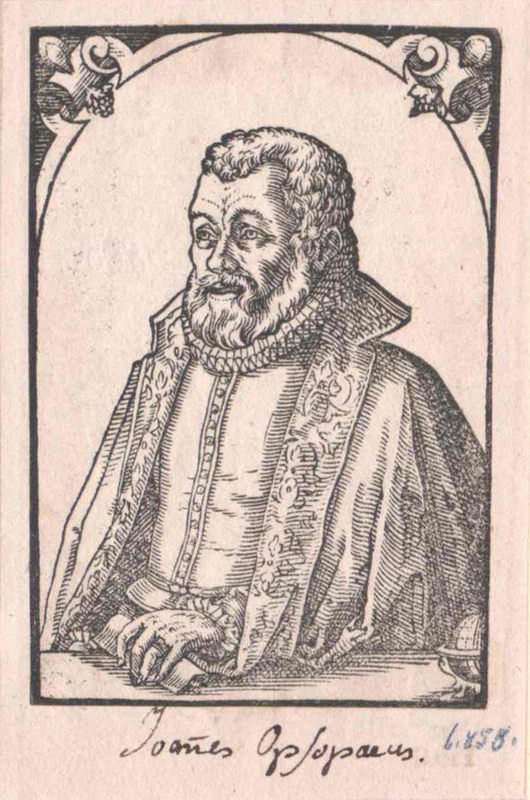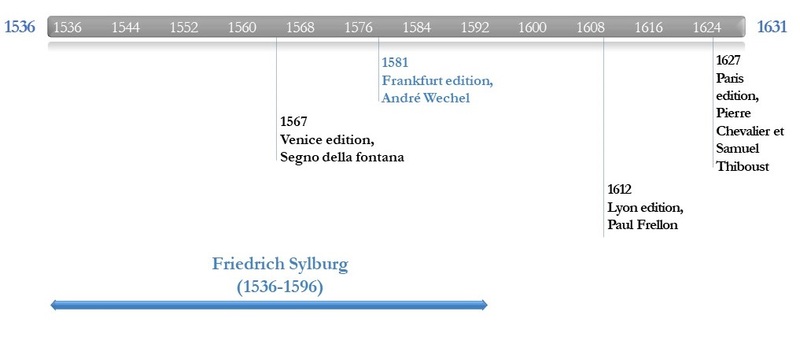
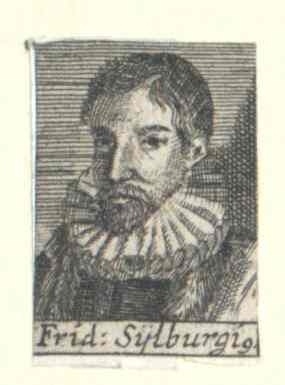
Portrait of Friedrich Sylburg
© Österreichische Nationalbibliothek Wien
Based on previously unevaluated archival documents, this biobibliographical essay has two aims: On the one hand, it will outline the stages of Friedrich Sylburg’s education and professional path from his early years in Wetter (Hesse) in the 1540s up to his death in Heidelberg in 1596.[1] On the other hand, it will outline the main areas of Sylburg’s broad editorial work, focusing especially on the formation contexts of the first Frankfurt edition of Natale Conti’s Mythologiae libri decem (1581).
Sylburg was born in Wetter near Marburg in 1536 as child of peasants (parentes nactus agricolas)[2] and lost his father at the age of seven.[3] He attended the local monastery school (‘Academiola Wetterana’) where he was taught among others by Justus Vulteius – who introduced him to Greek – and Johann Pincier, a reform theologian, and later Sylburg’s father in law.[4] Probably around 1558, Sylburg went to Strasbourg where he attended the college (‘Gymnasium’).[5] Among his teachers in Strasbourg were Johannes Sturm and the reform theologian Girolamo Zanchi; Sylburg became Zanchi’s assistant in 1561.[6] In Strasbourg, Sylburg also was supported by Philipp Conrad and Christoph Ernst, two of the sons of Philip I, Landgrave of Hesse, and Margarethe von der Saale.[7] In an undated poem of appreciation, Sylburg thanks them for their help, mentioning his ‘poor mother’ and his ‘unkind stepfather’ (est mihi namque domi paupercula mater; iniquus/ vitricus).[8]
In the late spring of 1563, Zanchi travelled through Switzerland and Italy (Baden, Zurich, Piuro, Zurich, Zurzach, Basel). Sylburg however seems to have rushed ahead of Zanchi for he already addresses himself on February 24, 1563 in Chiavenna to his ‘patron’ Philipp Conrad.[9] At any rate, Sylburg guided Zanchi back to Strasbourg where they arrived in June 1563. In response to religious controversies Zanchi left Strasbourg again in November 1563 and became a preacher at Chiavenna.[10] Sylburg once more accompanied him and remained in Chiavenna until April 1565 when he left to study at Padua.[11] Subsequently, Sylburg seems to have gone to Geneva where he worked for Henri Estienne. He helped to prepare Stephanus’ Thesaurus Graecae linguae that was published in 1572.[12] In April 1569, Sylburg stays at Frankfurt where he reports to Joachim Camerarius that he has left Geneva and taken several books and letters by Stephanus with him.[13]
In the period that follows, Sylburg became a teacher at the reform ‘Gymnasium illustre’ of Neuhausen near Worms that was founded by Frederick III, Elector Palatine, in 1565.[14] After the death of Frederick, his Lutheran son and successor Louis VI shut the Gymnasium in October 1577.[15] Subsequently, Sylburg’s cooperation with the Huguenot Andreas Wechel and his printing house in Frankfurt is documented by several publications beginning in 1578: Sylburg curated the edition of Jean de Gorris’ Definitiones medicae (1578).[16] In 1580 Sylburg published his edition of Nicolas Cleynaerts’ Institutiones ac meditationes in graecam linguam in which the correction was undertaken by Johannes Opsopoeus.[17] With Louis’ VI succession to power in 1576, Opsopoeus had to leave Heidelberg and became Wechel’s corrector.[18] In 1581, the first Frankfurt edition of Natale Conti’s Mythologiae libri decem was published. Opsopoeus was responsible for the Latin, Sylburg for the Greek passages ; he commented upon some new greek excerpts Conti added in this edition.[19] Wechel immediately sent a copy to Conti, who in December 1581 thanked Wechel, Sylburg and Opsopoeus for the accuracy of the Frankfurt edition (gratum exemplar: sed gratissima diligentia).[20] Wechel’s reasons for revising and printing Conti’s Mythologia are up for speculation. Besides the promising economic success of Conti’s manual – the Frankfurt edition underwent five impressions until 1596 – Wechel’s and Conti’s connections to Basel might be a hint as to why the Frankfurt edition was published in 1581. As early as in 1550, Conti published his Latin translation of Hermogenes’ Ars rhetorica at Pietro Perna’s Basel publishing house. In 1556, Conti’s Latin translation of Athenaios’ Deiphnosophistae was published at Heinrich Petri’s press in Basel. Conti’s Termini rhetorici followed in 1560.[21] Wechel in turn had several connections to Basel, and among others he stayed in contact with Theodor Zwinger, who’s editions of medical and philosophical treatises were printed by Pietro Perna in the 1560s and 1570s.
At beginning of November 1581, Andreas Wechel died in Frankfurt. His publishing house was closed and reopened in May 1582 by his sons-in-law Claude de Marne and Jean Aubry.[22] In December 1581, Wilhelm IV, Landgrave of Hesse-Kassel, and Ludwig IV of Hesse-Marburg, two of Philip’s I legitimate sons, decided to appoint Sylburg as professor of Greek to the University of Marburg.[23] Sylburg refused this appointment so that he could better concentrate on his editorial work.[24] Instead, ever since Wechel’s death, he had taken on the position of the schoolmaster at the monastery school of Lich (Hesse) where he taught Latin, Greek and French (Latinae ac Graecae linguae munus, quod mihi vna cum Gallicae rudimentis [...] demandatum est).[25] The books of account at the archives of the Marienstift in Lich prove his presence from 1581 up to Michaelis 1582 (29th of September) with an annual income of 60 guilders.[26]
Subsequently, at the end of 1582, Sylburg went to Frankfurt where he worked until 1591 as a corrector for Wechel’s heirs Marne and Aubry.[27] A first main project of this time is Sylburg’s edition of Aristotle's Opera in eleven volumes (1584–1587, the last three volumes were released after Sylburg’s death).[28] Sylburg dedicated his edition to the legitimate sons and successors of Philip I, Landgrave of Hesse.[29] In November 1587, Sylburg turned to the University of Marburg, asking for a scholarship that would allow him to undertake further editorial work. In his letter, Sylburg mentions the Frankfurt edition of Aristotle and announces an edition of Roman historians in three volumes that appeared from 1588 until 1590.[30] In February 1588 a yearly scholarship of 50 florins was granted to Sylburg by Wilhelm IV and Ludwig IV.[31]
In winter 1591, Sylburg left Frankfurt and became a corrector at Hieronymus Commelinus’ printing house in Heidelberg. The older biographical literature suggests a variety of reasons: Zeltner mentions the alleged order by the Elector Palatine to curate a collective edition of the Church Fathers.[32] In fact, over the course of the 1590s, Commelinus and Sylburg published several editions of Greek Church Fathers (Clement of Alexandria, Justin Martyr, Andreas of Caesarea).[33] Justi refers to Sylburg’s interest in the rich collection of books in the Bibliotheca Palatina,[34] whereas Preisendanz hints at the economic problems of Sylburg’s employers in Frankfurt.[35] In July 1595, Sylburg additionally became the provisional librarian of the Bibliotheca Palatina.[36] At the beginning of February 1596, Sylburg was even recommended by the senate of the University of Heidelberg as successor of Lambert Ludolf Pithopoëus, professor of Latin.[37] But on February 16 or 17, 1596, Sylburg died – either of the plague or exhaustion – and was buried in the cemetery of the Peterskirche in Heidelberg.[38] His estate was bought by the lawyer Johannes Gernand, who partially sold Sylburg’s books to the philologist Jan Gruter.[39] Gruter in turn had to leave the books in Heidelberg during his escape from the imperial troops in 1622.[40]
[1] For a biographical outline as well as an extensive review of Sylburg’s publications together with transcriptions and German paraphrases of its paratexts see Wilhelm Kühlmann et al., eds., ‘Friedrich Sylburg (Fridericus Sylburgius)’, in Die deutschen Humanisten. Dokumente zur Überlieferung der antiken und mittelalterlichen Literatur in der Frühen Neuzeit. Abteilung I: Die Kurpfalz. Bd. 4 [...] (Turnhout, 2013), 229–662. For Sylburg see also Wilhelm Kühlmann, ‘Einleitung’, in Die deutschen Humanisten. Dokumente zur Überlieferung der antiken und mittelalterlichen Literatur in der Frühen Neuzeit. Abteilung I: Die Kurpfalz. Bd. 4 [...], ed. Wilhelm Kühlmann et al. (Turnhout, 2013), XXI–XXV.
[2] Melchior Adam, ‘Fridericus Sylburgius’, in Vitae Germanorum Philosophorum [...] (Heidelberg, 1615), 416.
[3] As Sylburg states in 1591 in the preface of his Epicae elegiaecaeque minorum poetarum gnomae (cf. Kühlmann et al., ‘Friedrich Sylburg (Fridericus Sylburgius)’, 576).
[4] Cf. Kühlmann et al., 577. The name of Pincier’s (younger) daugther as well as the date of marriage are unknown. Pincier’s older daughter Rebecca married Jakob Alsted, who’s son Johann Heinrich Alsted hence is Sylburg’s nephew (cf. Howard Hotson, Commonplace Learning. Ramism and Its German Ramifications, 1543–1630 [Oxford, 2007], passim).
[5] In the preface of Justin’s Opera (1593), Sylburg mentions that he studied ‘nearly five years’ (‘quinquennium fere’) in Strasbourg that he left in December 1563 (Kühlmann et al., ‘Friedrich Sylburg (Fridericus Sylburgius)’, 607). For Sylburg’s connection to Sturm cf. Karl Preisendanz, ‘Ein unbekannter Jugendbrief des Neuhumanisten Friedrich Sylburg (1563)’, Schweizer Beiträge zur Allgemeinen Geschichte 18/19 (1960/1961): 249. Former visits of Sylburg at the Universities of Marburg and Jena are reported by Karl Wilhelm Justi, Friedrich Sylburg. Ein biographischer Versuch (Marburg, 1818), 4. They are neither confirmed by the Marburg nor the Jena matriculation register.
[6] Cf. Preisendanz, ‘Ein unbekannter Jugendbrief des Neuhumanisten Friedrich Sylburg (1563)’; Henri Meylan, ‘Girolamo Zanchi et son “Famulus”’, Studi e materiali di storia delle religioni 38, no. 1 u. 2 (1967): 396–402.
[7] For Philip’s bigamous marriage see Jean-Yves Mariotte, ‘Philipp der Großmütige von Hessen (1504-1567). Fürstlicher Reformator und Landgraf’, Veröffentlichungen der Historischen Kommission für Hessen 24 (Marburg, 2018), 142–61.
[8] Sylburg’s poem includes 21 distichs and is adressed to the ‘Illustriss[imis]. et Generosiss[imis]. Principibus: D[omino]. Christophoro Ernesto; et D[omino]. Philhippo Cunrado, Lantgr[avii]: Hess[iae]. FF[Fratribus].: Dominis suis clementiss[imis].’ (Hessisches Staatsarchiv Marburg, Best. 1, Nr. 1357).
[9] Cf. Hessisches Staatsarchiv Marburg, Best. 1, Nr. 1380. Sylburg’s contact to Philipp Conrad might also be the missing link to identify the dedicatee of Sylburg’s copy of Theodoret’s De providentia (cf. Karl Preisendanz, ‘Zu Friedrich Sylburgs Bibliothek’, Neue Heidelberger Jahrbücher. [...], 1938, 120–22).
[10] For Zanchi’s and Sylburg‘s two visits in Switzerland and Italy see Preisendanz, ‘Ein unbekannter Jugendbrief des Neuhumanisten Friedrich Sylburg (1563)’, 243–48.
[11] Cf. Preisendanz, 248. According to Meylan, Sylburg might have stayed in Padua until autumn 1563 since Zanchi recommended him at the end of October 1563 to Heinrich Bullinger in Zurich (cf. Meylan, ‘Girolamo Zanchi et son “Famulus”’, 401 [n. 15]).
[12] According to Jung, Sylburg studied in Paris and worked here for Stephanus, cf. Johann Georg Jung, Vita Friderici Sylburgii [...] (Berleburg u. Frankfurt, 1745), 12-13. This information is contrary to the fact that Stephanus went to Geneva as early as 1557 (cf. Hans Widmann, Der Drucker-Verleger Henri II Estienne (Henricus II Stephanus) [...] [Mainz, 1970], 10).
[13] Cf. Sylburg’s letter to Camerarius in Leipzig on April 5, 1569: ‘S[alutem]. Quum Geneua discederem, dedit mihi Henr. Stephanus sententias comicorum Graecorum, et duo exemplaria epistulae cuiusdam suae ad amicos, cui addidit catalogum librorum à se excusorum: duo item querimoniae artis typographicae. iussitque me ad te perferenda ea curarem. Dedi igitur cuidam vestrati bibliopolae unà cum ipsius Henrci literis ad te scriptis. Vale et Ludovicum F. meis verbis saluta [...]’ (Universitätsbibliothek Erlangen-Nürnberg, Briefsammlung Trew, H62/TREWBR SYLBURG_FRIEDRICH[1, urn:nbn:de:bvb:29-bv043530734-3). For Sylburg’s connections to Estienne’s philological workings cf. Jean Céard, ed., La France des humanistes. Henri II Estienne, éditeur et écrivain, Europa Humanistica (Turnhout, 2003), passim.
[14] Cf. Joachim Schalk, ‘Das Gymnasium illustre zu Neuhausen bei Worms, eine kurpfälzische Fürstenschule’, in 475 Jahre Rudi-Stephan-Gymnasium Worms. Festschrift zum Schuljubiläum [...], ed. Burkhard Keilmann, Humanitas. Mitteilungsblatt des Rudi-Stephan-Gymnasiums Worms 47 (Worms, 2002), 66–86 (Sylburg is mentioned on p. 80). According to Jung, Sylburg became Collega tertius (Jung, Vita Friderici Sylburgii [...], 14); hence he earned 100 guilders annually, one cart load of wine and one mortar of grain (cf. Schalk, ‘Das Gymnasium illustre zu Neuhausen bei Worms, eine kurpfälzische Fürstenschule’, 75).
[15] Cf. Schalk, ‘Das Gymnasium illustre zu Neuhausen bei Worms, eine kurpfälzische Fürstenschule’, 76.
[16] Cf. Ian Maclean, ‘André Wechel at Frankfurt, 1572-1581’, Gutenberg-Jahrbuch 63 (1988): 149 (n. 17). Maclean refers to 1577 as the date of publishing whereas I only found the edition of 1578.
[17] Cf. Kühlmann et al., ‘Friedrich Sylburg (Fridericus Sylburgius)’, 235-36. For Sylburg’s works on Greek grammar see Engelbert Drerup, Die Schulaussprache des Griechischen von der Renaissance bis zur Gegenwart [...]. Erster Teil: Vom XV. bis zum Ende des XVII. Jahrhunderts (Paderborn, 1930), 334–40.
[18] Cf. Wilhelm Kühlmann et al., eds., ‘Johannes Opsopoeus’, in Die deutschen Humanisten. Dokumente zur Überlieferung der antiken und mittelalterlichen Literatur in der Frühen Neuzeit. Abteilung I: Die Kurpfalz. Bd. 3 [...], Europa Humanistica 9 (Turnhout, 2010), 143.
[19] See Andreas Wechel’s letter to the ‘candid reader’ (Candido Lectori) as well as Sylburg’s Notae at the end of Natalis Comitis Mythologiae, Sive Explicationum fabularum, Libri decem [...] (Frankfurt, 1581). For Sylburg’s scrupulous correction of the Greek passages and his doubts on the authenticity of Conti’s Greek sources, cf. Victor Gysembergh, ‘La Réputation Sulfureuse de Natale Conti Helléniste Faussaire’, in La Mythologie de Natale Conti éditée par Jean Baudoin. Livre I (1627), ed. Céline Bohnert and Rachel Darmon, Héritages Critiques (Reims, 2020), 189–195.
[20] See Natale Conti’s letters to Andreas Wechel, written in Venice on the 3rd of December 1581, printed just before the beginning of the Mythologia’s first book in the second Frankfurt edition (Natalis Comitis Mythologiae, Sive Explicationum Fabularum, Libri decem [...] [Frankfurt, 1584]).
[21] For the three Basel editions cf. Frank Hieronymus, 1488 Petri. Schwabe 1988. Eine traditionsreiche Basler Offizin im Spiegel ihrer frühen Drucke. Zweiter Halbband (Basel, 1997), 1071-72. as well as 1110-11.
[22] Cf. Christoph Reske, Die Buchdrucker des 16. und 17. Jahrhunderts im deutschen Sprachgebiet. Auf der Grundlage des gleichnamigen Werkes von Josef Benzing, Beiträge zum Buch- und Bibliothekswesen 51 (Wiesbaden, 2007), 237 and 241-42.
[23] Cf. Archiv der Philipps-Universität Marburg, Best. 305 a, Nr. 5955.
[24] Cf. Jung, Vita Friderici Sylburgii [...], 16: ‘sed is provinciam sibi oblatam ex amore libertatis & βιβλιογονíας desiderio submisse detrectavit.’
[25] Sylburg in the preface to his Notae on Cleynaerts’ and Antésignan’s Grammatica, printed in 1583 (Kühlmann et al., ‘Friedrich Sylburg (Fridericus Sylburgius)’, 247-48). Here, Sylburg in August 1582 addresses the Counts of Solms-Münzenberg, who in 1579 erected a new school building in Lich (cf. Karl Sames, ‘Von Licher Schulhäusern’, in Licher Heimatbuch [...] [Lich, 1950], 248-49). For the tradition of the Lich monastery school until the 1550s cf. Waldemar Küther, Das Marienstift Lich im Mittelalter (Lich, 1977), 156–58 as well as 212.
[26] Cf. Archiv des Marienstifts Lich, Lich AZ 516 (1580–1609), Cammerregister. I would like to thank Inge Steul (Lich) cordially for supplying this information.
[27] Cf. Karl Preisendanz, ‘Aus Friedrich Sylburgs Heidelberger Zeit’, Neue Heidelberger Jahrbücher. [...], 1937, 68 (n. 3).
[28] Cf. Kühlmann et al., ‘Friedrich Sylburg (Fridericus Sylburgius)’, 334–419.
[29] Kühlmann et al., 335–49.
[30] Cf. Hessisches Staatsarchiv Marburg, Best. 17 h, Nr. 2635.
[31] Cf. Hessisches Staatsarchiv Marburg, Best. 17 h, Nr. 2635. See also [...] Catalogi studiosorum scholae Marpurgensis cum Annalibus brevibus coniuncti particula septima (Marburg, 1879), 29: ‘Anno Christi 1588. decima tertia die Ianuarii Fridericus Silleburgius Hassus, qui Francofurti in Typographia Vuecheliana elaborandis renouandisque vetustis autoribus ac libris, Graecis praesertim, operam daret, eaque in re industriam suam et excellentem Graecarum literarum scientiam doctissimis quibusque viris approbasset: de voluntate illustrissimorum Principum nostrorum, quibus a Schola fuerat commendatus, et quibus non ita pridem Aristotelem a se repurgatum dedicauerat, quinquaginta florenorum stipendium annuum a Schola hac impetrauit, quo commodius eis, quas dixi, operis suis vacare posset.’
[32] Cf. Johann Conrad Zeltner, ‘Fridericus Sylburgius’, in C. D. Correctorum in Typographiis Eruditorum Centuria [...], by Johann Conrad Zeltner (Nürnberg, 1716), 528-29: ‘Postquam enim ipsius Friderici II. Electoris Palatini jussu ad Commelinum Heidelbergam commigrasset, editionem omnium Ecclesiae Patrum ibidem curaturus, & summo studio emendaturus, evenit, ut pestilentissima lues [...] Heidelbergam infestaret.’ Frederick II in fact died in 1556. For Commelin’s plan to publish a full edition of the Church Fathers see anyway Axel E. Walter, Späthumanismus und Konfessionspolitik. Die europäische Gelehrtenrepublik um 1600 im Spiegel der Korrespondenzen Georg Michael Lingelsheims, Frühe Neuzeit 95 (Tübingen, 2004), 297.
[33] According to Scultetus’, Commelinus’ and Sylburg’s plan to print a collective edition of the Church Fathers emerged after these editions, cf. Gustav Adolf Benrath, ed., Die Selbstbiographie des Heidelberger Theologen und Hofpredigers Abraham Scultetus (1566-1624), Veröffentlichungen des Vereins für Kirchengeschichte in der evang. Landeskirche in Baden 24 (Karlsruhe, 1966), 38: ‘Es hatte sich auch zu der Zeit Hieronymus Commelin, der berühmte Buchdrucker, vorgenommen, durch Hülf des Durchleuchtigsten Friederich des IV. Chur-Fürsten Pfaltzgraffen, aber durch Fleiß und Arbeit Friederich Sylburgii aus der Grafschaft Wetteraw in Hessen, daß er alle alte Kirchenlehrer in ein Buch zusammendrucken wollte, wie er dann kurz zuvor solches seines Vornehmens eine herrliche Prob getan hatte in dem Justino Martyre, Clemente Alexandrino, dem Ephesischen Concilio, in des Theodoreti Therapeuticis und etlich andern.’
[34] Cf. Justi, Friedrich Sylburg. Ein biographischer Versuch, 8: Sylburg ‘ging nach Heidelberg, wohin ihn hauptsächlich der Reichthum der seltensten Bücher und kostbarsten Handschriften lockte’.
[35] Cf. Preisendanz, ‘Aus Friedrich Sylburgs Heidelberger Zeit’, 55; Karl Preisendanz, ‘Friedrich Sylburg als Verlagsberater’, Gutenberg-Jahrbuch, 1937, 195-96.
[36] Cf. Elmar Mittler, ed., Bibliotheca Palatina. Katalog zur Ausstellung vom 8. Juli bis 2. November 1986. Heiliggeistkirche Heidelberg. Textband (Heidelberg, 1986), 435.
[37] Cf. Preisendanz, ‘Aus Friedrich Sylburgs Heidelberger Zeit’, 65–67.
[38] Cf. Preisendanz, 65.
[39] Cf. Preisendanz, ‘Zu Friedrich Sylburgs Bibliothek’.
[40] Cf. Walter, Späthumanismus und Konfessionspolitik. Die europäische Gelehrtenrepublik um 1600 im Spiegel der Korrespondenzen Georg Michael Lingelsheims, 285.
Maximilian Bach

